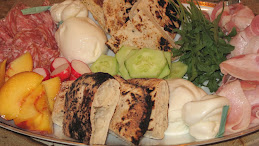
Turning into a bit of a theme or an obsession or something perhaps, the weekly asparagus blog, but this vegetable is so fabulous and its time is so brief, what the hell I'm going to add another. It was the lovely boyfriend's birthday last week so we went out for a splendid supper mid week, then I planned to make a special meal at home over the weekend just to keep the party theme going. (Any excuse.) I rifled through the recipe books and consulted my sweetheart on what he fancied as a special treat. His first choice for first course was asparagus soup. Not just any soup though, it had to be the one from Gordon Ramsay's Secrets. A spectacularly good choice, it has to be said.
Although not hugely complex to make it is time-consuming. Each step has to be done properly, and using only the best ingredients. The time used will be well rewarded. Using recipes from chef's of the calibre of the brilliant Mr Ramsay is one way to make the produce shine - it is often the small things presented as 'garnish' or 'to finish the dish' that are the most revelatory. For this soup, it is whipping double cream with truffle oil to float on the hot soup that lifts this dish from fabulous to heavenly. Rich, earthy, delicate - wow.
Eating well is very much a two way process. You can make a terrible dish using the finest ingredients but you cannot make brilliant food using sub standard ingredients. It will never happen. It seems to me that it also part of the pleasure of good food to have an ever increasing skill in the kitchen and with that knowledge comes confidence to try more and different things thus broadening your repertoire. If you stick to the produce of the seasons it will also make sense of the year - given time.
Asparagus Soup with truffle cream
Make this soup in the spring when homegrown asparagus is in season and available at a good price. You don't need to seek out young, tender spears - it's the flavour you need, not the texture. You will achieve a good result with a combination of stalks and trimmings, so don't discard the woody ends and peelings if you're serving asparagus as a vegetable - use them here. Adding a couple of handfuls of tender spinach leaves helps to boost the natural asparagus colour without detracting from the flavour.
1kg green asparagus (including trimmings if available)
75g butter
1 onion chopped
1 fat garlic clove, chopped
750ml of chicken or vegetable stock
100g baby leaf spinach
sea salt and fresh ground black pepper
To serve
150ml double cream
1/2 teaspoon truffle oil
2 teaspoons finely chopped chives
Chop the asparagus into small even sized pieces. Heat the butter in a large saucepan and, when it starts to sizzle, add the onion and garlic. Sauté gently for about 10 minutes until softened but not coloured. Add the asparagus pieces and sauté for a further 5-10 minutes until softened. Meanwhile, bring the stock to the boil in another pan. Pour the hot stock over the asparagus, season to taste and simmer for 3 minutes. Then stir in the spinach and cook briefly, unti ljust wilted. Immediately remove from the heat and strain the stock, reserving the vegetables.
Purée the vegetables in a blender or food processor, gradually adding the hot stock back until you have a creamy liquid. Pass the soup through a fine mesh sieve into a clean pan. Rub the pulp in the sieve with the back of a ladle to extract as much flavour as possible.
To serve, lightly whip the cream with truffle oil and seasoning until softly peaking. Reheat the soup gently until almost at a simmer, but do not boil or you will destroy the amazing colour and flavour. Serve in warm bowls topped with dollops of truffle cream and chopped chives.
The drip on the edge of the plate is optional!









